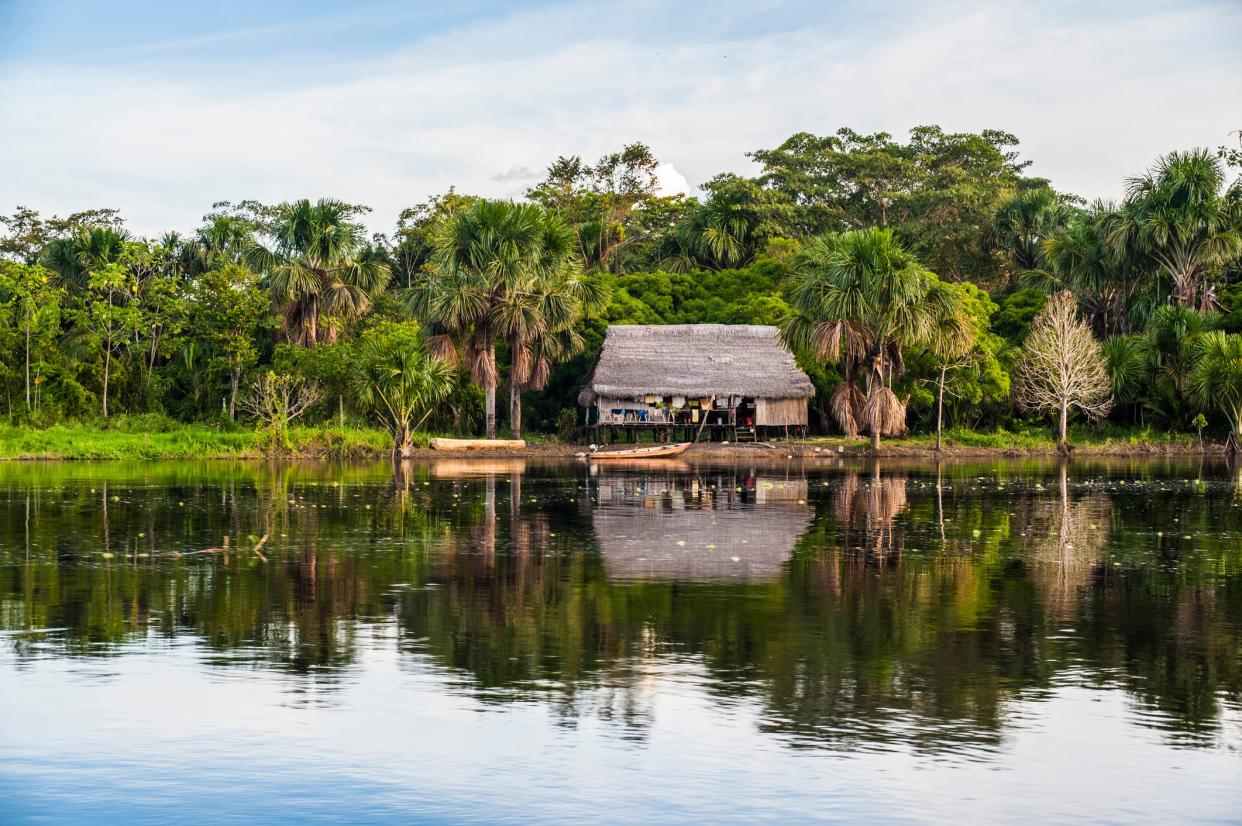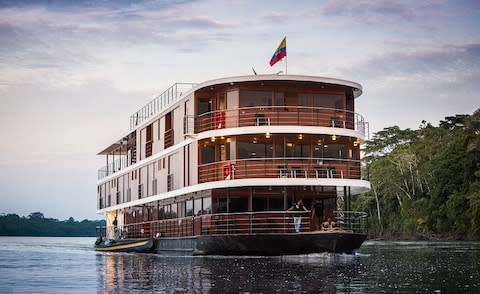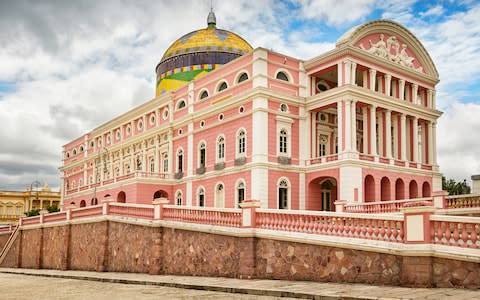Everything you need to know about booking an Amazon river cruise

The Amazon is the world’s longest river. It’s a vast natural basin that drains an area the size of Australia. It’s a mighty ecosystem. It’s an unimaginably huge forest whose very survival is tied to the planet’s. Named after legendary female warriors, it has itself become a kind of myth.
And it can seem like a very confusing place to plan a cruise. How long should a voyage be? Which country or countries? Which ports? What kind of ship? Up or downstream? The many tributaries that feed the Amazon – sometimes called headwaters – are more pristine and therefore richer in biodiversity than the mainstream; consequently, in recent years, the Peruvian and Ecuadorian headwaters have become increasingly popular with birders and wildlife-lovers, on and off the river.
The Brazilian Amazon is more often in the news as a flashpoint in the global climate-change and habitat-loss debates. But it’s 2,000 miles from the mouth of the river on the Atlantic coast and the major Peruvian port of Iquitos – and development has had different kinds of impact in different areas. Note, too, that, from Manaus upriver Brazilians call the Amazon “Solimoes”.
Whichever of the cruising options you choose from the below, the beauty and variety of the river will not escape you. Discovered by Europeans in the 1490s – probably by accident – the river is as wide as a sea in some areas. But take a turn into its forested fringes and you enter the realm of the pink river dolphin and giant otter, blue macaws and pink-faced monkeys. Voyages in ships are almost always combined with trips in smaller vessels –from zodiacs to motorised launches to canoes – to go piranha fishing, birding or on night cruises, looking out for caiman. Memorable, magnificent, mythic, the Amazon remains a cruise of a lifetime.
When to go
High water is November to May. Parts of the forest are flooded and this means you can paddle or motor into remote stretches off the main rivers. Low water, from June to October, is typically best for seeing predators – from caiman to storks – fight over remaining food sources. It rains 200 days per year and so expect rain whenever you go.

Yasuni National Park, Ecuador
Coca to Yasuni National Park
Ecuador’s Napo river is a major tributary of the Amazon and the port of Coca was the departure point for 16th century conquistador Francisco de Orellana, the first European to navigate from high upriver to the Atlantic Ocean. It’s also the embarkation port for cruises that explore the Yasuni National Park, an extraordinary – yet little-studied – biodiversity hotspot boasting fauna such as jaguar, spider and squirrel monkey, caiman and tarantulas, and equally amazing flora, including strangler fig, huge kapok trees and even bigger ceiba, which have massive buttresses to keep them aloft in the thin soil.
Cruises use smaller boats to head into the flooded forest to see some of the wildlife and to visit members of the Waorani and Kichwa indigenous communities, who still practise hunting in the rainforests. Since 2015, the luxurious 148-foot Anakonda has given visitors a luxury option in the region; the vessel has just 18 twin berths, with a gourmet restaurant, observation deck, spa, in-room Jacuzzis and canoes and kayaks for low-level paddling.

How to do it: Steppes Travel can arrange a 12-day Ecuador Andes & Amazon holiday, combining seven nights aboard Anakonda with visits to Quito and Avenue of the Volcanoes from £4,545. Flights from £950 return (01285 880980, steppestravel.com).
The Mamoré, Bolivia
Trinidad to the Mamoré River
The Amazon is about the great unknown – and Bolivia’s Amazon basin region is one of the least explored. The Mamoré is a 1,000-mile-plus tributary that runs south-north from the eastern lowlands into Brazil, where it meets the Beni and Madre de Dios. It’s an off-radar area, where there’s a good chance of seeing capybaras, caimans and pink dolphins. The only cruise-type vessel operating here, the 14-cabin Reina de Enin “Flotel”, is not as luxurious as some of the Brazilian or Peruvian boats, but is more than comfortable and comes equipped with canoes so you can set off to explore three kinds of forest, and spot monkeys, turtles, rheas, anteaters, sloths and more. Keen-eyed birdwatchers may catch harpy eagles and the endemic blue-throated macaw. There’s also an opportunity to meet the Mojeña and Yurakaré people who live in the forest.
How to do it: Geodyssey offers a six day tour of Trinidad, including three nights on board the Reina de Enin, from £1,250pp, based on two people sharing a twin/double bedroom. The price includes: domestic return flights from La Paz/Santa Cruz to Trinidad, all meals on board, shared services of local English speaking guide, transfers to the cruise port (16km from Trinidad) and two nights accommodation in the city of Trinidad, with a half-day city tour (020 7281 7788, geodyssey.co.uk).
Manaus and the Rio Negro
Manaus to the Anavilhanas National Park
A famous day-trip out of Manaus – the only major city in Brazil’s Amazonas province – is to see the Meeting of the Waters, where the chocolatey Amazon meets the blue-black Rio Negro; due to different densities, the hues don’t ever fully mix. The mighty Negro, which runs for 1,400 miles northwest from Manaus all the way to Guainía in Colombia, is the largest “left” tributary of the Amazon. It’s also one of South America’s easiest Amazon experiences and also one of the best for viewing pink river dolphins, caiman and lots of Amazonian birds. A bus from Manaus – or a floatplane – takes you 110 miles upstream to the tiny riverside hamlet of Novo Airão, where comfortable riverboats take small groups into the Anavilhanas national park, an extraordinarily beautiful area of green islands, flooded forests, dense jungle and calm waterways protecting a range of rare species from jaguar to giant otter to Amazonian manatee.

How to do it: Bespoke Brazil’s 10-night Amazon Explorer tour includes six nights exploring the Negro aboard the stylish, comfortable M/Y Tucano, with all meals and guided activities included. From £4,260 per person, the package also covers a night in Manaus and three nights in Rio de Janeiro, all B&B, plus flights from the UK (01603 340680, bespokebrazil).
Iquitos and Pacaya Samiria
Iquitos/Nauta to Pacaya Samiria national reserve
Connected to Lima and the rest of Peru only by air, Iquitos is the definitive Amazon river port. First settled in 1624, it’s grown from a backwater into a city of half a million souls, and played a major role in the 19th century rubber boom. Ocean vessels of 18-foot draft can reach Iquitos from the Atlantic, which is 2,200 miles away. Far more popular, however, is to use the lively, chaotic city as a base for visiting Pacaya Samiria national reserve, 115 miles southwest. The large reserve, which lies between the Marañón and Ucayali tributaries, contains three river basins, flooded forests (in season), lakes, gorges and canals – it is listed as a Ramsar wetland – and areas of dry land. Endangered or threatened species protected here include giant otter and Arrau and yellow-spotted river turtles, living alongside howler, squirrel and saddleback tamarin monkeys, scarlet and blue-and-yellow macaws, paiche or pirarucu fish (which can grow as long as ten feet), hoatzin and caiman.

Tours exploring the park sail from Iquitos or Nauta and range from the heritage rubber-era steamship Rio Amazonas (built on the Clyde in 1889) to state-of-the-art vessels such as the Aria Amazon, Zafiro and Delfin I, II and III boats.
How to do it: Flights to Iquitos operate from Lima and, since earlier this year, Cuzco, with Latam. Journey Latin America offers a 13 day Luxury Peru: Andes to Amazon holiday visiting Machu Picchu with three nights on board the MV Aria from Iquitos from £7,283 per person. The price includes domestic flights in Peru, transfers, excursions, most meals and first class accommodation. International flights are extra and start at £630 per person (020 8600 1881, journeylatinamerica.co.uk).
The Classic Amazon Cruise – Brazil’s magnificent mainstream
From Belém to Manaus and Tefe
A trip from Belém at the river’s mouth on the Atlantic Ocean mouth all the way to Tefe remains a classic slow voyage into the heart of South America. If you’re on a budget you can catch a local passenger vessels, mingling with working-class locals and enjoying a chilled beer while watching footy on the ship’s TV – the only snow you’re likely to see. Even from the middle of the massive mainstream, you might see caiman, toucans, monkeys, parrots and macaws. You’ll certainly get a full sense of the immensity of the rainforest and, indeed, the river. Changing boats at Manaus, take a day or two to see the famous opera house and enjoy some terra firma dinners. Travel to Tefe, where you can enjoy a full wildlife experience at the floating Uakari Lodge in the Ramsar-listed Mamirauá Reserve, named for the rare red-faced monkeys that inhabit the canopy here.
How to do it: It takes four to five days to travel from Belém to Manaus. Further upriver, some speed boats operate, as well as slow river vessels. You can book this independently, though it’s best to use a specialist UK tour operator to arrange bookings, cabins and transfers – see the website of the Latin American Travel Association for operators; expect to pay from £100-£300 for a low-budget cruise, the price varying according to the kind of berth (hammock, cabin with air-con etc). Explore offers a 16-day itinerary using a public boat along a section of the Amazon, a flight and a private vessel up the Rio Negro, including a tour leader, some meals, and international flights, from £3,885 (01252 883 476, explore.co.uk).
Crossing frontiers: Peru to Brazil via Colombia
Iquitos to Belém
For those who want the cruise experience without the hassles of changing vessels, there are occasional expedition-style voyages undertaken by medium-sized ship with shallow draughts all the way from the Atlantic mouth at Belém to Iquitos in Peru, and back again. Zodiac landings mean passengers get to see out-of-the-way wildlife spots, narrower waterways such as the Breves Channels, as well as rarely visited ports such as Leticia in Colombia. Vessels are usually staffed by wildlife experts, botanists and ornithologists.
How to do it: Hapag Lloyd offers an 18-day cruise from Belem to Iquitos in Peru aboard the new (i.e. still being built) 230-passenger Hanseatic Inspiration expedition ship. Departs 11 April 2020. From £8,636. (00 49 40 3070 30 555, hl-cruises.com).

Amazon lite
Barbados to Brazil
Why not combine the Amazon with an oceangoing cruise? A number of ships plying the Atlantic coasts of South America link Belém, Santarem or Manaus with the Caribbean. You get to see the main port cities, learn history, take in the Meeting of the Waters at Manaus, and indulge in the food and luxury cabins of a larger ship. You also get fun cabaret shows, comedy, dancing and live music and use of on-board leisure facilities such as swimming pools, Jacuzzis and a gym. These cruises show the proximity of Brazil to the rest of the Americas – so you see the coast rather as the early explorers did.
How to do it: Fred Olsen’s 14-night Amazon River Adventure aboard Braemar (maximum 929 passengers) departs from Bridgetown, Barbados, and makes a stop in Granada, before visiting Belém, Santarém – plus the famous beaches of Alter do Chao – and Manaus. From £2,749 (0800 130 3189, fredolsencruises.com).

